 If you ever hear someone say they’re going to Patagonia, it’s safe to assume they’re a scientist, a mad keen hiker, or a hermit craving inhospitable solitude.
If you ever hear someone say they’re going to Patagonia, it’s safe to assume they’re a scientist, a mad keen hiker, or a hermit craving inhospitable solitude.
This land at the southern tip of Chile is a windswept place of sparkling glaciers, turquoise lakes and snow-capped mountains. Trees grow horizontally in the gales that churn the Magellan Straights, a treacherous stretch of ocean with a serious track record of shipwrecks. It’s pure geographical drama, in other words, if you’re a hardy outdoors adventurer.
Even getting here is a mission, since Patagonia is separated from the rest of Chile by the Campo del Hielo Sur – the southern icefield. Flights from Santiago land at Punta Arenas, and from there you follow a coastal road called the ruta al fin del mundo - route to the end of the world.
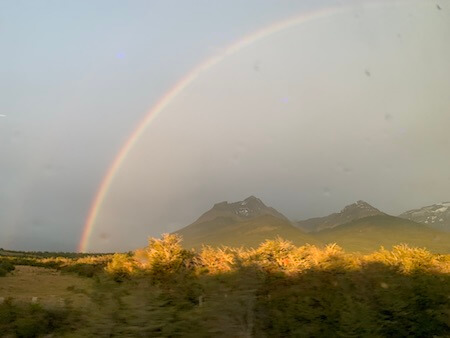 Surprisingly, you can still enjoy this wilderness even if you’re a wimp like me who says: ‘it’s gorgeous, but I’m going back inside out of the cold now.’ The first trick is to visit during the milder months of December to March before the snow descends. Summer days can be quite benign, although the bright sun rarely overpowers the icy wind. The right clothes are essential too. I dressed up like a spy from the French resistance, with a long black cashmere coat, boots, gloves and a beret, then spoiled the attempt at glamour by adding a bright red plastic wind sheeter that just flapped uselessly in the rain-soaked gusts.
Surprisingly, you can still enjoy this wilderness even if you’re a wimp like me who says: ‘it’s gorgeous, but I’m going back inside out of the cold now.’ The first trick is to visit during the milder months of December to March before the snow descends. Summer days can be quite benign, although the bright sun rarely overpowers the icy wind. The right clothes are essential too. I dressed up like a spy from the French resistance, with a long black cashmere coat, boots, gloves and a beret, then spoiled the attempt at glamour by adding a bright red plastic wind sheeter that just flapped uselessly in the rain-soaked gusts.
Life here is tough, and few humans can endure it. Ample evidence of that comes in the Magellan Straits Park, where an excellent museum covers various historic events, most of which ended badly. One display pinpoints the sites of ill-fated ships that crashed again rocks, sank in storms, or mysteriously burned to oblivion.
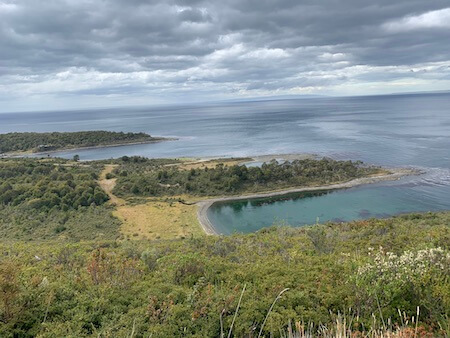 Another highlights the pioneers, the brave and the foolhardy who attempted to settle here, including 337 Spaniards who arrived in 1584 to control this oceanic shortcut around the continent. Three years later only two survivors remained at Puerto del Hambre (Port Famine) and one of them died on the boat that rescued them.
Another highlights the pioneers, the brave and the foolhardy who attempted to settle here, including 337 Spaniards who arrived in 1584 to control this oceanic shortcut around the continent. Three years later only two survivors remained at Puerto del Hambre (Port Famine) and one of them died on the boat that rescued them.
Centuries later in 1843 some Chilean sailors founded Fort Bulnes as perhaps the bleakest, loneliest, coldest outpost on earth. Five years later the lack of drinking water and fertile land saw them retreat inland to establish Punta Arenas. Their log cabins, church and jail were decomposing until Fort Bulnes was rebuilt in the 1940s using the original techniques to commemorate their efforts.
Today Punta Arenas is a blustery port dotted with elegant 19th century mansions built by wool barons, who discovered that sheep fare better than humans on the vast, treeless plains of Patagonia. The cemetery is another grand affair that captures the city’s history on one site, with mausoleums devoted to the Spaniards, the Brits and the Croatians who all sought their fortunes in this remote land.
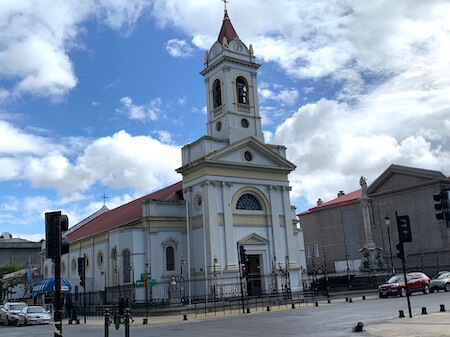 A brisk walk away is the central market, full of craft stalls and seafood eateries. I ordered what I thought was seafood paella, and was served a delicious chunky soup bristling with mussels, prawns, pieces of fish and other unidentifiable bits of sea life. It was nicely priced too, in what is generally an expensive region. Partly because everything has to be imported, and partly due to the short tourism season. As one charming man told me in his overpriced restaurant, they need to make enough money in three or four months to survive the full year.
A brisk walk away is the central market, full of craft stalls and seafood eateries. I ordered what I thought was seafood paella, and was served a delicious chunky soup bristling with mussels, prawns, pieces of fish and other unidentifiable bits of sea life. It was nicely priced too, in what is generally an expensive region. Partly because everything has to be imported, and partly due to the short tourism season. As one charming man told me in his overpriced restaurant, they need to make enough money in three or four months to survive the full year.
The small town of Puerto Natales 250km north has a bustling vibe around a central area of bars, restaurants, and shops selling camping gear. This is the gateway to Torres del Paine, one of Chile’s most beautiful national parks. A full rainbow touched the mountains as we approached the park early one morning, setting a magical tone that promised something special. Then our guide warned us that the highlight of the day, a boat trip to Grey Glacier, may not happen because wind was making the water too choppy. I don’t know if it was true, or just a ploy to generate enthusiastic cheers when we heard that the boat trip was happening.
The sight of glaciers glistening white and blue in the sun is spectacular, and we crowded onto the two decks to drink it in. A few massive chunks of ice that had broken off were reflecting the light to appear vivid blue against the grey water.
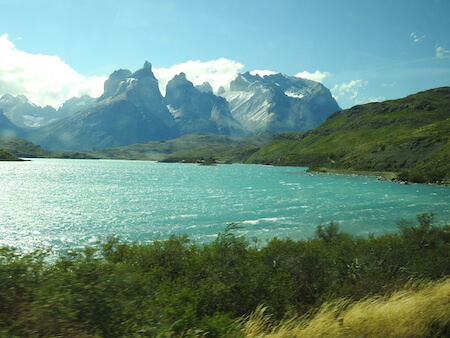 The planet-loving part of me had thrown a moral tantrum when I’d read that they serve lumps of glacial ice in your whisky after the viewing. One lump for every person on every boat ride every day – I felt I was destroying the planet singlehandedly. Then I saw that the ice is fished out of the lake from chunks that have already broken off, so they’re not physically attacking the glacier with a pickaxe. I relented, and was mesmerised by a block of the clearest ice I’ve ever seen, filled with tiny bubbles.
The planet-loving part of me had thrown a moral tantrum when I’d read that they serve lumps of glacial ice in your whisky after the viewing. One lump for every person on every boat ride every day – I felt I was destroying the planet singlehandedly. Then I saw that the ice is fished out of the lake from chunks that have already broken off, so they’re not physically attacking the glacier with a pickaxe. I relented, and was mesmerised by a block of the clearest ice I’ve ever seen, filled with tiny bubbles.
Another unmissable sight in Torres del Paine is the torres themselves, some weirdly shaped granite towers behind a picturesque lake. At one viewpoint we braved a headwind to reach Salto Grande waterfall, gushing strongly from the rain. There’s a handrail around the viewing ledge for a very good reason. We were buffeted at every step, and when the wind paused for a second it was only to draw a bigger breath and smack us even harder.
Some young people were playfully leaning over backwards to let the wind support them, until the guide ran over to chivvy them away from the cliff edge. I wiped the raindrops from my camera and stabilised myself to photograph the towers, my plastic mac whipping in the wind.
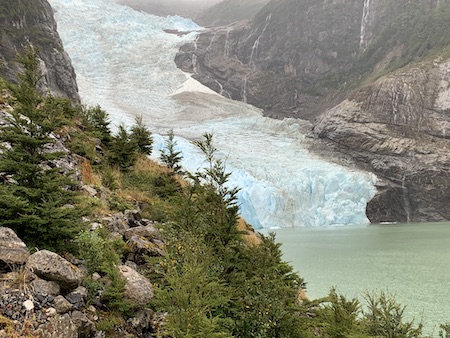 The next day some fellow travellers returned cold and bedraggled after a day-long hike to the base of the mountains, with only half of them completing it. As someone who knows my limits, I’d make the smart decision to spend the day on a boat instead, sailing up the Señoret Channel to see Balmaceda and Serrano glaciers.
The next day some fellow travellers returned cold and bedraggled after a day-long hike to the base of the mountains, with only half of them completing it. As someone who knows my limits, I’d make the smart decision to spend the day on a boat instead, sailing up the Señoret Channel to see Balmaceda and Serrano glaciers.
It took a couple of hours to reach a pier where we disembarked and followed a path along a mountainside. After two or three viewing points you reach the final stop, and look over Témpanos Lagoon to see Serrano Glacier, a river of ice coming down the mountain to the water. It’s awesome and immense, and yet in one way it isn’t.
A good 10 minutes before the final viewpoint we passed a pole that marked where the glacier had been 50 years ago – countless tons of ice have melted in those intervening years. Later we moored up to see Balmaceda Glacier, with the ice sitting high above the water on the side of a mountain. A few years ago the glacier had reached the water, but all that ice has gone.
Witnessing such vivid effects of climate change on this pristine area heightens the melancholy feel of Patagonia. It’s bleak, cold, wet and windy, and that inhospitable nature has protected its spectacular beauty. Yet it’s changing fast.
First published in Business Day.